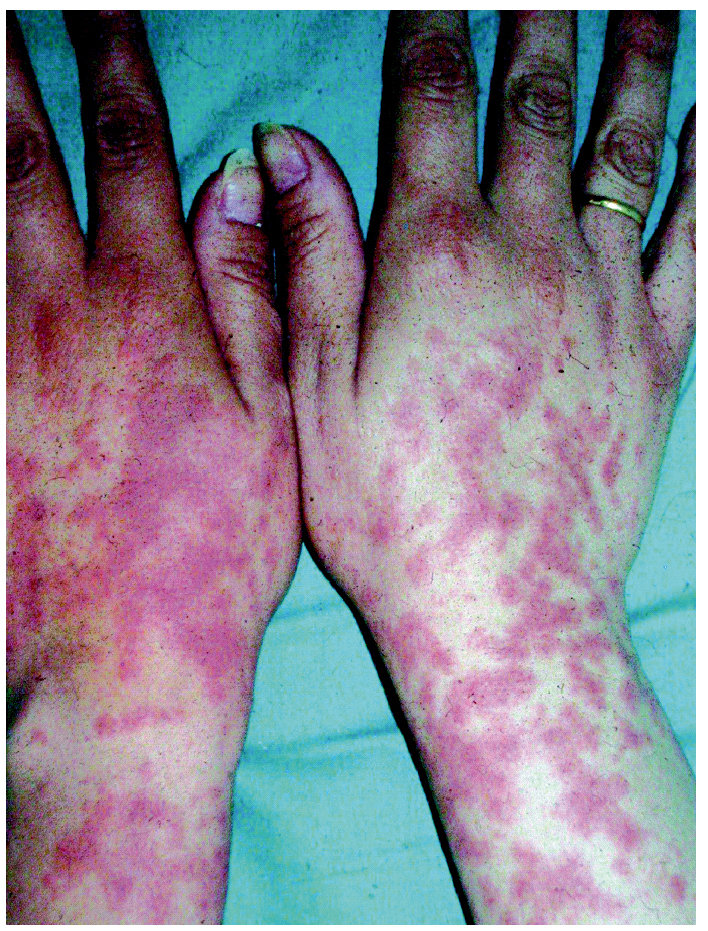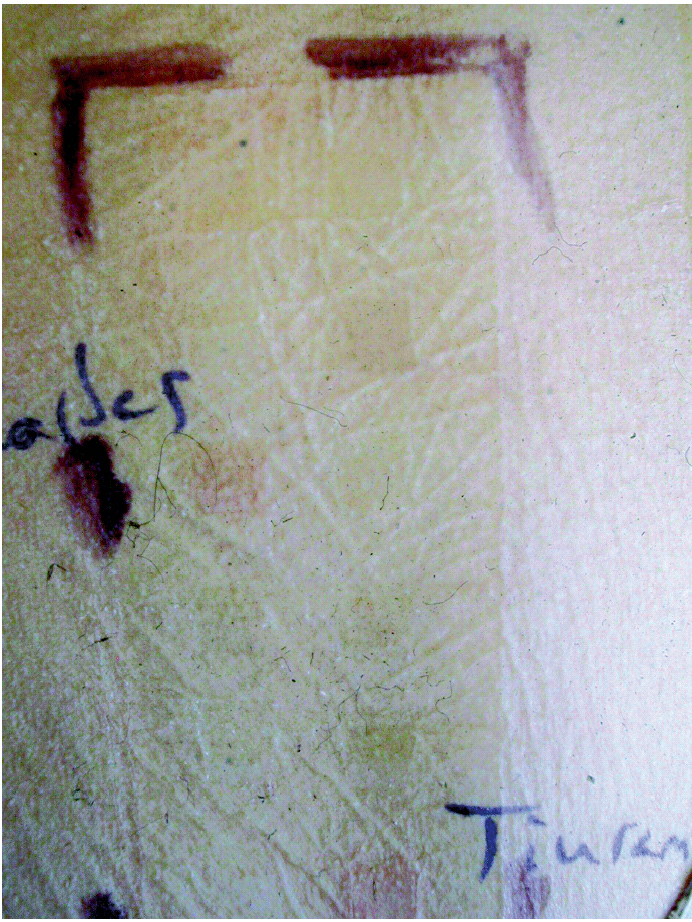CLINICAL CASE
A 38 years old woman, without personal or familiar history of atopy. She presents with mildly pruritic, eritematous and edematous plaques, from 1 to 1.5 centimeters, involving her hands and forearms, in their dorsal and ventral aspects, covering almost the whole surface of the affected region, with a perfect clear proximal border, at the middle third of the forearms, like a glove, since 2 weeks ago. Some of the lesions have a target-like appearance. Lesions weren't eroded nor excoriated. She didn't present any lesion at other sites of her body (fig. 1).
Figure 1.--Aspect of the lesions.
Giving the distribution of the lesions, we made a directed anamnesis, looking for any kind of contact wich may produced contact dermatitis, and our patient refered using a new rubber gloves brand for houseworking since 1 month before. She didn't report any other suspicious contact. She had never suffered from herpes simplex.
A provisional diagnosis of erythema multiforme-like contact dermatitis was made. To confirm this, skin biopsy, epicutaneous tests and prick tests with latex was performed, and latex-specific IgE in serum determined.
The skin biopsy showed a lichenoid pattern, with necrotic keratinocites, basal vacuolar changes, spongiosis and linfocitic inflamatory infiltrate at mid and papillary dermis, and at dermo-epidermal junction, being, therefore, compatible with our first clinical diagnosis. Prick test and specific IgE were negative. We made patch tests with standard series of the GEIDC (Grupo Español de Investigación en Dermatitis de Contacto) (TRUETest®, Alk-Abelló, Madrid), with readings at 48 and 96 hours; positive results to carbamates mix (+ + / + + +), and to thiuram mix (+ + / + + +), following ICDRG guidelines (International Contact Dermatitis Research Group) were obteined (fig. 2).
Figure 2.--Result of patch tests.
Definitive diagnosis of erythema multiforme-like contact dermatitis was established. Lesions cleared after gloves substitution.
DISCUSSION
We present a case of erythema multiforme-like contact dermatitis to carbamates and thiuram. They are substances used in transforming natural rubber, material useful to make several industrial and home rubber instruments; among these are natural rubber gloves.
Natural rubber comes from the tree Hevea braziliensis, from the Amazonic region. Through incisions along the bark, pours a milky substance, called latex, because of its appearance. This raw material must be modified for its better use in factories, passing through a series of transformations, such as coagulation, vulcanization, moulding, ... till the desirable physical and chemical properties are reached. To get this, several intermediary substance are used, like accelerators, preservers or stabilizers. The most common vulcanization accelerators are carbamates and thiuram, often involved in type IV hypersensibility reactions as sensitizers 1.
Main differential diagnosis in our case is urticaria to latex, secondary to a type I reaction to its peptids, that can manifest as a broad spectrum from urticaria to anaphylactic reactions and death. There were been made a lot of assays to determine its protein concentration 3, find the main epitopes responsibles of this reactions 2, get clear the relationship between type I reactions latex and cross reactivity against other alergens, and also to determine if a type IV reaction against latex exists 4.
Some peptids, with diferent body weight, were identified as main allergens of latex, and were denominated as Hev b, following of a number from 1 to 6. Some of these peptids were associated with several entities, as occurs between Hev b1 and 3 and bifid spine. Nevertheless, there are many other known and unknown allegerns that probably have a paper in reactions to latex, and it's calculated that 20 to 50 per cent of cases are due to these secondary allergens. Examples of these secondary peptids are profilin, chitinase, enolase, lisozime, also present in some fruits and vegetables, as banana 2, melon 6 or orange, and probable responsibles of cross reaction between latex and fruits.
Latex sensitization is more frequent among healthcare workers, factory workers who handle latex products, and people who have had several surgical operations; all these people have in common a very intense or repeated contact with latex 8. There have been reported cases of latex allergy before contact with gloves, balloons, condoms, needles for insuline injection, and also due to aerotransportated latex particles 9. This latter mechanis is secondary to products derivated of cornflour, with low molecular weight, recently introducted as part of the inner powder in several trades of latex gloves; these products link gentle to latex particles, releasing them into the air. It has been demonstrated that, like happens in children with spina bifida, the more the number of surgical operations, the more the probabilities of become sensitized 2.
The best tests to diagnose latex allergy are prick tests and specific IgE in serum, because it's a type I hypersensibility. Results must be correlated with clinical findings, as there have been found a 12 % of healthy controls with positive specific IgE; a positive result in prick test is more specific. These data suggest that there may be presensitized, but clinically asymptomatic, people 6.
Latex sensitization is less common than we can expect, since most of the patients refered to a dermatologist who suffer from contact dermatitis to rubber products, are due to other substances used in the rubber elaboration as preservatives or vulcanization accelerators; among of the latter are carbamates and thiurams 1,5. In the last decade, thiurams were being substituted for carbamates, since these are less allergenics 5. A reduction in sensitization to thiuram mix in healthcare workers, determined by patch test, supports this situation 1; however this sensitization shows a recent slight elevation, probably due to the use of cheaper rubber gloves brands 5.
In clinical studies made among people with high risk to develop contact dermatitis to rubber gloves, like odontologists, nurses, hairdressers or cleaning workers, thiurams are the most common allergens, especially tetraethylthiuramdisulfide (TETD), followed by ditiocarbamates and, at more distance, mercaptobenzothiazole and tioureas. There are patients sensitized to both thiurams and carbamates; it's common that almost all patients sensitized to carbamates are also to thiurams; this is not true at the other way round; this means that many people sensitized to thiurams could use gloves containing carbamates 5.
Sensitization to carbamates and thiurams causes a type IV hypersensibility reaction, so it should be diagnosed by patch testing. Standard series used in Spain contains a thiurams mix, formed by tetramethylthiuramdisulfide (TMTD), tetraethylthiurammonosulfide (TETM), tetraethyilthiuramdisulfide (TETD) y dipentamethylenethiuramdisulfide (DPTD). Carbamates mix, part of standard series, includes 1,3 diphenylguanidine (DPG), Zn-diethyldithiocarbamate (ZDEC) and Zn-dibuthyldithiocarbamate (ZDBC). The most common clinical presentation is like hand contact dermatitis. Our case presented like an erythema multiforme like eruption.
Contact erythema multiforme-like eruption is a rare manifestation of non-eczematous allergic contact dermatitis. It was also called urticarial papules and plaques eruption 9. Clinical presentation is variable, from localized affectation of the contact area, like our case, to diseminated eczema and even toxic epidermic necrolysis. It's believed that the main mechanism is a type IV cell-mediated hypersensibility, after exposure to strong allergens, or repeated exposures to mild allergens 12,16. There have been implicated lots of allergens, like several metals, topical steroids, topical NSAIDs, plants, exotic woods or industrial chemical products 10,12,15. A case similar to ours was reported in 2001, but without patch testing nor biopsy 11. When biopsy was taken, in almost all the cases histopathology findings was similar to those seen in typical erythema multiforme 12. Diagnosis of contact erythema multiforme should be make considering clinical findings, with characteristic lesions, and positive patch testing, and excluding other causes of urticarial eruptions. It must be taken in mind that there were reported some cases with diseminated lesions after patch testing 9,12. Once diagnosed, therapeutics approaches are similar to those taken in typical erythema multiforme, in addition to avoid the responsible allergen.
Given the frequency of contact dermatitis to rubber gloves, other kind of materials gloves are appearing; but there have already been described contact dermatitis to these new products, like poliethylene or nitrile gloves 13,14.
CONCLUSIONS
We present a case of contact erythema multiforme-like eruption to carbamates and thiuram, two vulcanization accelerators, often implicated in contact dermatitis. In fact, most of the cases of troubles with natural rubber things, are due to these components rather than latex. Taking in mind that sensitization is easier after repeated contacts, health authorities should act in critical sectors like healthcare workers, to avoid contact dermatitis related morbilidity.








